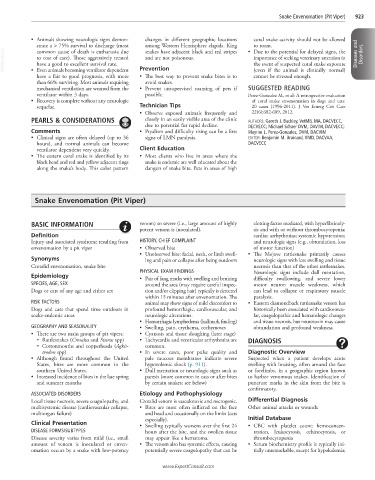Page 1840 - Cote clinical veterinary advisor dogs and cats 4th
P. 1840
Snake Envenomation (Pit Viper) 923
• Animals showing neurologic signs demon- changes in different geographic locations coral snake activity should not be allowed
to roam.
strate a > 75% survival to discharge (most among Western Hemisphere elapids. King • Due to the potential for delayed signs, the
VetBooks.ir to cost of care). Those aggressively treated Prevention importance of seeking veterinary attention in Diseases and Disorders
snakes have adjacent black and red stripes
common cause of death is euthanasia due
and are not poisonous.
the event of suspected coral snake exposure
have a good to excellent survival rate.
• Even animals becoming ventilator dependent
have a fair to good prognosis, with more • The best way to prevent snake bites is to (even if the animal is clinically normal)
cannot be stressed enough.
than 66% surviving. Most animals requiring avoid snakes.
mechanical ventilation are weaned from the • Prevent unsupervised roaming of pets if SUGGESTED READING
ventilator within 3 days. possible. Perez-Gonzalez M, et al: A retrospective evaluation
• Recovery is complete without any neurologic of coral snake envenomation in dogs and cats:
sequelae. Technician Tips 20 cases (1996-2011). J Vet Emerg Crit Care
• Observe exposed animals frequently and 22(6):682-689, 2012.
PEARLS & CONSIDERATIONS closely in an easily visible area of the clinic AUTHORS: Gareth J. Buckley, VetMB, MA, DACVECC,
due to potential for rapid decline. DECVECC; Michael Schaer DVM, DAVIM, DACVECC;
Comments • Ptyalism and difficulty rising can be a first Mayrim L. Perez-Gonzalez, DVM, DACVIM
• Clinical signs are often delayed (up to 36 signs of LMN paralysis. EDITOR: Benjamin M. Brainard, VMD, DACVAA,
hours), and normal animals can become DACVECC
ventilator dependent very quickly. Client Education
• The eastern coral snake is identified by its • Most clients who live in areas where the
black head and red and yellow adjacent rings snake is endemic are well educated about the
along the snake’s body. This color pattern dangers of snake bite. Pets in areas of high
Snake Envenomation (Pit Viper)
BASIC INFORMATION venom) to severe (i.e., large amount of highly clotting factor mediated, with hyperfibrinoly-
potent venom is inoculated). sis and with or without thrombocytopenia;
Definition cardiac arrhythmias; systemic hypotension;
Injury and associated syndrome resulting from HISTORY, CHIEF COMPLAINT and neurologic signs (e.g., obtundation, loss
envenomation by a pit viper • Observed bite of motor function)
• Unobserved bite: facial, neck, or limb swell- • The Mojave rattlesnake primarily causes
Synonyms ing and pain or collapse after being outdoors neurologic signs with less swelling and tissue
Crotalid envenomation, snake bite necrosis than that of the other rattlesnakes.
PHYSICAL EXAM FINDINGS Neurologic signs include dull mentation,
Epidemiology • Pair of fang marks with swelling and bruising difficulty swallowing, and severe lower
SPECIES, AGE, SEX around the area (may require careful inspec- motor neuron muscle weakness, which
Dogs or cats of any age and either sex tion and/or clipping hair) typically is detected can lead to collapse or respiratory muscle
within 15 minutes after envenomation. The paralysis.
RISK FACTORS animal may show signs of mild discomfort to • Eastern diamondback rattlesnake venom has
Dogs and cats that spend time outdoors in profound hemorrhagic, cardiovascular, and historically been associated with cardiovascu-
snake-endemic areas neurologic alterations. lar, coagulopathic and hematologic changes
• Hemorrhagic lymphedema (hallmark finding) and tissue necrosis, but neurotoxin may cause
GEOGRAPHY AND SEASONALITY • Swelling, pain, erythema, ecchymoses obtundation and profound weakness.
• There are two main groups of pit vipers: • Cyanosis and tissue sloughing (later stage)
○ Rattlesnakes (Crotalus and Sistrus spp) • Tachycardia and ventricular arrhythmias are DIAGNOSIS
○ Cottonmouths and copperheads (Agkis- common.
trodon spp) • In severe cases, poor pulse quality and Diagnostic Overview
• Although found throughout the United pale mucous membranes indicate severe Suspected when a patient develops acute
States, bites are more common in the hypovolemic shock (p. 911). swelling with bruising, often around the face
southern United States. • Dull mentation or neurologic signs such as or forelimbs, in a geographic region known
• Increased incidence of bites in the late spring paresis (more common in cats or after bites to harbor venomous snakes. Identification of
and summer months by certain snakes; see below) puncture marks in the skin from the bite is
confirmatory.
ASSOCIATED DISORDERS Etiology and Pathophysiology
Local tissue necrosis, severe coagulopathy, and Crotalid venom is vasculotoxic and necrogenic. Differential Diagnosis
multisystemic disease (cardiovascular collapse, • Bites are most often inflicted on the face Other animal attacks or wounds
multiorgan failure) and head and occasionally on the limbs (cats
especially). Initial Database
Clinical Presentation • Swelling typically worsens over the first 24 • CBC with platelet count: hemoconcen-
DISEASE FORMS/SUBTYPES hours after the bite, and the swollen tissue tration, leukocytosis, echinocytosis, or
Disease severity varies from mild (i.e., small may appear like a hematoma. thrombocytopenia
amount of venom is inoculated or enven- • The venom also has systemic effects, causing • Serum biochemistry profile is typically ini-
omation occurs by a snake with low-potency potentially severe coagulopathy that can be tially unremarkable, except for hypokalemia;
www.ExpertConsult.com

